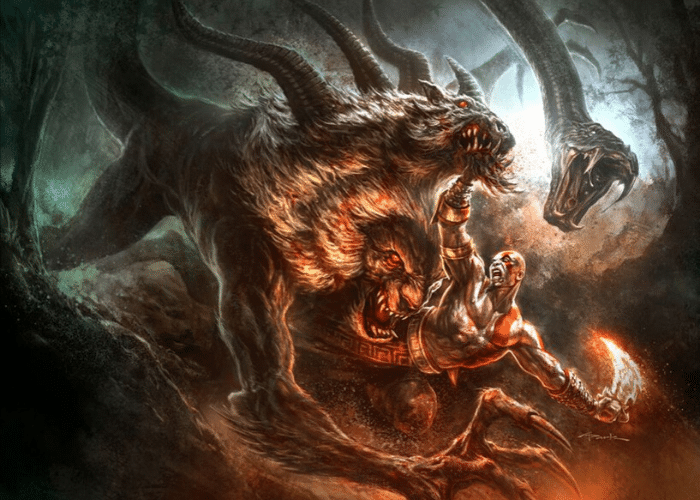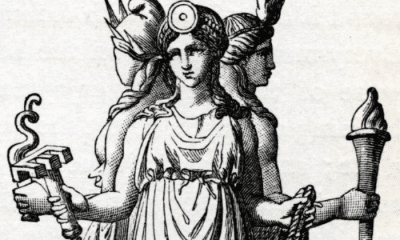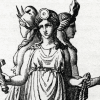
Greek
What is a Chimera?
What is a Chimera?
Many monsters from different times and cultures have been described as chimeras, but what was the original Greek Chimera and how was it different from the others?
The word chimera is used often today as a general descriptor, but it comes from a very specific source. The Greek Chimera was an individual monster who was so distinctive that its name came to represent an entire archetype.
The Chimera was a hybrid monster, combining the forms of three well-known animals into one unnatural form. This was a common feature not only in Greek legends, but in mythologies from around the world.
In the Greek story, the Chimera was a fire-breathing monster with three heads and nearly impenetrable skin. The hero Bellerophon was only able to kill it with the help of another hybrid, the flying horse Pegasus, and a clever plan.
Long after the story of Bellerophon was largely forgotten, the name of the monster lived on. Chimera as a word came to mean any type of fearsome hybrid monster that inspired dread and uneasiness.
The Chimera in Greek Myth
The Chimera is one of the most memorable monsters in Greek mythology.
It was first described by Homer as, “a thing of immortal make, not human, lion-fronted and snake behind, a goat in the middle, and snorting out the breath of the terrible flame of bright fire.”
This brief description was expanded upon by later writers and artists. Soon, the Chimera was described as having three heads.
Artists usually showed these heads as being connected to the part of the body they corresponded to, rather than all in the front like most other multi-headed monsters. So the Chimera had the head of a lion, a goat’s head growing out of its back, and a serpent’s head at the end of its tail.
This image seemed to contradict the myth, however, which usually seemed to imply that the Chimera only breathed and blew flames from a single mouth.
In the legend, the Chimera was said to live in Asia Minor where it utterly destroyed an entire region. The hero Bellerophon was given the task of killing the monster.
Aided by both Athena and Poseidon, Bellerophon tamed Pegasus to complete this task. The flying horse had the speed and agility to keep him out of the path of the monster’s fiery breath.
Even with this help, the hero was not able to even wound the beast. Like the Nemean Lion, who was often said to be the Chimera’s offspring, it had nearly impenetrable hide.
Bellerophon finally succeeded by breaking off the tip of his spear in the monster’s throat. When it attempted to shoot flames at him the lead tip melted, blocking the Chimera’s airway and suffocating it on its own flames.
My Modern Interpretation
While the Greeks used the name Chimera to refer to a specific mythological monster, the word has since been used to describe many different creatures.
The Greek Chimera was just one of many creatures of legend that were hybrids. These monsters combined the forms of many different animals, both real and fantastic.
While the Chimera was an individual creature in Greek mythology, by the Middle Ages the name was applied to any of these hybrid monsters. Medieval chimeras had little resemblance to the form described by Homer and painted on Greek vases beyond the fact that they were hybrids.
Many Greek myths had largely been forgotten by this time, including that of Bellerophon and the Chimera. While the name was remembered as that of a grotesque monster, the exact form and powers of the Chimera was not familiar to most medieval writers and artists.
They gave a new interpretation to the hybrid monster, usually showing it with a scaly body and a human-like face. The medieval chimera was a symbol of the evils of the non-Christian world.
This re-imagining of the chimera continues to influence how the word is used today. In modern English the term is applied to any hybrid creature, even being used in science when two distinct sets of DNA occur in the same individual.
In some ways the modern usage of the word is in keeping with the Greek concept of the Chimera. While they used the name for an individual monster, the Chimera was part of a long tradition of hybrid monstrosities.
Hybrid monsters, commonly referred to today as chimeras themselves, occur in mythologies from around the world. From China to the Aztec Empire, many cultures have imagined creatures that combined elements of multiple animals.
These imagined forms can belong to gods, like the animal-headed deities of Egypt, or benevolent creatures, like Greece’s own Pegasus. Very often, however, they are terrifying monsters.
Humanity has long had a fascination with the grotesque, and creatures that seemed to violate the nature rules of the world inspired fear. The combination of familiar forms into unnatural creatures could be more frightening than something that was wholly imagined.
Like the later medieval forms, the Greek Chimera inspired fear by combining animal features in an unnatural way. It was so effective at doing so that its name was used for these fearsome monsters long after its specific mythology faded from prominence.
Like many mythological creatures, the Chimera also represented a real feature of the world. The fire-breathing monster was said to have lived in a region that to this day is noted for natural gas vents that create flames across the landscape.
Like many Greek myths, the story of the Chimera used fantastic elements to explain a natural phenomenon. The creature whose flames eternally changed the landscape of Lycia was imagined in a way that was universally intimidating.
In Summary
The Chimera was a specific hybrid monster in Greek mythology. It had the head of a lion, the torso of a goat, and the tail of a serpent.
The Chimera was usually described as having three heads, like many monsters in ancient Greek legends. These heads, however, grew across its body instead of all at the front and corresponded to the three creatures that made up its form.
The fire-breathing monster was slayed by the hero Bellerophon. Even with the advantage of riding on the back of Pegasus, he was only able to kill the creature by lodging his lead spear tip in its throat so that it suffocated on its own flames.
The story of Bellerophon faded from popular knowledge in the post-classical era, but the name of the creature he killed remained. In the Middle Ages, it was applied to several grotesque hybrid animals that represented the terrors of the non-Christian world.
The word chimera is still used to describe hybridization and is applied to creatures from around the world. Mythologies and folklore across the globe feature similar hybrid terrors that are commonly referred to as chimeras.
The Chimera lent its name to the entire archetype of hybrid monsters that combined natural forms in unnatural ways to inspire fear.



